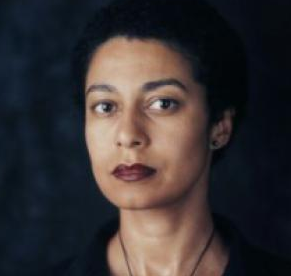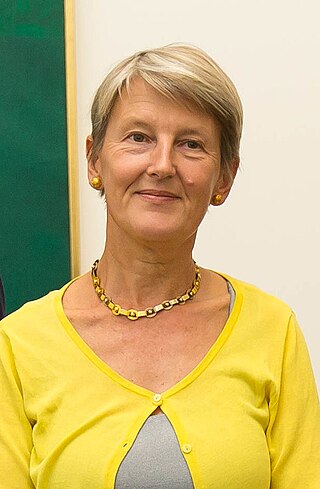Related Research Articles
Amelia Jones, originally from Durham, North Carolina, is an American art historian, art theorist, art critic, author, professor and curator. Her research specialisms include feminist art, body art, performance art, video art, identity politics, and New York Dada. Jones's earliest work established her as a feminist scholar and curator, including through a pioneering exhibition and publication concerning the art of Judy Chicago; later, she broadened her focus on other social activist topics including race, class and identity politics. Jones has contributed significantly to the study of art and performance as a teacher, researcher, and activist.

Johanna Drucker is an American author, book artist, visual theorist, and cultural critic. Her scholarly writing documents and critiques visual language: letterforms, typography, visual poetry, art, and lately, digital art aesthetics. She is currently the Martin and Bernard Breslauer Professor in the Department of Information Studies at the Graduate School of Education and Information Studies at UCLA. In 2023, she was elected to the American Philosophical Society.

Helen Barbara Howard was a Canadian painter, wood-engraver, draughtsperson, bookbinder and designer who produced work consistently throughout her life, from her graduation in 1951 from the Ontario College of Art until her unexpected death in 2002.

Sandra Kemp is an academic and curator with a background in English literature. She is the director, The Ruskin - Library, Museum and Research Centre at University of Lancaster and visiting professor in the Department of Materials at Imperial College London. She was previously a research associate at IMAGES&CO, and has held leadership roles in the university and cultural sectors, most recently as senior research fellow at the Victoria and Albert Museum, head of college, London College of Communication and director of research at the Royal College of Art (RCA). She curated the Wellcome Trust-sponsored exhibition Future Face: Image, Identity, Innovation at the Science Museum, with a related programme at the National Portrait Gallery, a film festival and a debate on BBC Radio Five Live. She has also published and given public lectures in the fields of fiction, literary theory and cultural studies.

Elaine Shemilt is a British artist and researcher especially known as a fine art printmaker.

Maud Sulter was a Scottish contemporary fine artist, photographer, writer, educator, feminist, cultural historian, and curator of Ghanaian heritage. She began her career as a writer and poet, becoming a visual artist not long afterwards. By the end of 1985 she had shown her artwork in three exhibitions and her first collection of poetry had been published. Sulter was known for her collaborations with other Black feminist scholars and activists, capturing the lives of Black people in Europe. She was a champion of the African-American sculptor Edmonia Lewis, and was fascinated by the Haitian-born French performer Jeanne Duval.
Barbara Kirshenblatt-Gimblett is a scholar of Performance and Jewish Studies and a museum professional. Professor Emerita of Performance Studies at New York University, she is best known for her interdisciplinary contributions to Jewish studies and to the theory and history of museums, tourism, and heritage. She is currently the Ronald S. Lauder Chief Curator of the Core Exhibition and Advisor to the Director at POLIN Museum of the History of Polish Jews in Warsaw.

Kavita Singh was an Indian art historian. A professor of art history, she served as the dean at the School of Arts and Aesthetics of Jawaharlal Nehru University.
J. R. Carpenter is a British-Canadian artist, writer, and researcher working across performance, print, and digital media. She was born in Nova Scotia in 1972. She lived in Montreal from 1990 to 2009. She emigrated to England in 2010, and became a British citizen in 2019. She now lives in Southampton, England.
Oreet Ashery is an interdisciplinary artist based in London.
Lorna Brown is a Canadian artist, curator and writer. Her work focuses on public space, social phenomena such as boredom, and institutional structures and systems.
Monica Tap is a Canadian painter, artist and educator. She lives in Toronto, Ontario, and teaches at the University of Guelph. She is known for engaging and challenging conventions concerning landscape and still-life painting.

Penelope Curtis is a British art historian and curator. Fom 2015 to 2020 she was the director of Lisbon's Museu Calouste Gulbenkian, and from 2010 to 2015 director of Tate Britain. She is the author of several monographs on sculpture and has written widely at the invitation of contemporary artists.
Skawennati is a Mohawk multimedia artist, best known for her online works as well as Machinima that explore contemporary Indigenous cultures, and what Indigenous life might look like in futures inspired by science fiction. She served as the 2019 Indigenous Knowledge Holder at McGill University. In 2011, she was awarded an Eiteljorg Contemporary Art Fellowship which recognized her as one of "the best and most relevant native artists."

Judith Tucker is a British artist and academic. She completed a BA in Fine Arts at the Ruskin School of Art, St Anne's College, Oxford, (1978–81) an MA in Fine Arts (1997–98) and a PhD in Fine Arts at the University of Leeds (1999–2002). Tucker is co-convenor of LAND2, a research network of artists associated with higher education who are concerned with radical approaches to landscape with a particular focus on memory, place and identity. She exhibits regularly in the UK and Europe. Between 2003 and 2006, Tucker was an Arts and Humanities Research Council (AHRC) Research Fellow in the Creative and Performing Arts.

Heather L. Igloliorte is an Inuk scholar, independent curator and art historian from Nunatsiavut.
Lyne Lapointe is a French-Canadian artist. Her work ranges from site-specific installations (1981–1995), found-objects, drawings, and paintings, with focuses on art history, museology, botany, and feminism. She has exhibited extensively in Montreal, Quebec, and New York City, New York, and across Canada. She now lives and works in Mansonville, Quebec.
Andrea Fatona is a Canadian independent curator and scholar. She is an associate professor at OCAD University, where her areas of expertise includes black, contemporary art and curatorial studies.
Isabelle Hayeur is a Canadian visual artist known for her photographs and experimental film. Hayeur’s works are inspired by a critical analysis of ecology and urbanity. Since the late 1990s, Hayeur has created public art commissions, photography books, video installations, and has participated in many solo and group exhibitions. Her artworks can be found in both national and international collections, including those of the National Gallery of Canada, the Vancouver Art Gallery, the Art Gallery of Ontario, the Art Gallery of Alberta (Edmonton), the Musée d’art contemporain de Montréal, the New Orleans Museum of Art and the Museum of Contemporary Photography in Chicago, and the Fonds national d’art contemporain in Paris.
Professor Nancy Underhill is an art historian, curator, lecturer and author. She is the Founder of the University of Queensland Department of Art History.
References
- ↑ Fleming, Martha (15 September 2006). "Visiting Professor, Faculty of Health, Copenhagen « Martha Fleming : arts | sciences | humanities : interdisciplines". www.marthafleming.net. Retrieved 9 August 2020.
- ↑ "Martha Fleming". Lichtenberg-Kolleg. 1 October 2019. Retrieved 9 August 2020.
- ↑ Fleming, Martha (11 June 2009). "Split + Splice « Martha Fleming : arts | sciences | humanities : interdisciplines". www.marthafleming.net. Retrieved 9 August 2020.
- ↑ Fleming, Martha (January 2011). "Strategic Research Clusters Programme: Centre for Arts and Humanities Research at the Natural History Museum". Strategic Research Clusters Programme.
- ↑ Centre for Collections Based Research PhD Programme, University of Reading
- ↑ Moulds, Alison (18 May 2018). "Interview: Martha Fleming". BSHS. Retrieved 9 August 2020.
- ↑ Fleming, Martha (22 July 2019). "Embodied ephemeralities: Methodologies and historiographies for investigating the display and spatialization of science and technology in the twentieth century". History of Science. 59 (2): 197–219. doi:10.1177/0073275319858528. ISSN 0073-2753. PMID 31328558. S2CID 198134203.
- ↑ Fleming, Martha (2013). "Split + Splice: an experiment in scholarly methodology and exhibition making". In Goodyear; Weidekamp (eds.). Analyzing Art and Aesthetics. Artefacts Volume 9. Smithsonian Institution Scholarly Press. Retrieved 16 August 2020– via scholar.google.com.
- ↑ Obituary by Noreen Shanahan, The Globe and Mail, 1 April 2008
- ↑ Peter Fleming, Furniture Studio Head and Faculty, Bachelor of Crafts and Design, Sheridan College, Ontario
- ↑ Jernigan, Amanda (31 July 2018). Richard Outram's Early Poems (1957-1988): A Critical Introduction with Annotations (PDF) (Doctor of Philosophy thesis). McMaster University.
- ↑ Fleming, Martha; Fleming, Allan; Tombs, Robert; Crawley, Devin; Braggins, Donna; Payne, Carol; Donnelly, Brian (15 January 2018). The Fleming Files: Allan Fleming's Life & Works. The Porcupine's Quill. ISBN 978-0-88984-955-6.
- ↑ Frye, Northrop (January 2003). Northrop Frye's Notebooks and Lectures on the Bible and Other Religious Texts. University of Toronto Press. ISBN 978-0-8020-3766-4.
- ↑ "Leonardo Abstracts Service". Pomona College. Retrieved 9 August 2020.
- ↑ "Artforum.com". www.artforum.com. Retrieved 9 August 2020.
- ↑ Fleming, Martha. "The Production of Meaning: Karl Beveridge and Carol Condé". Open Letter. 1983: 147–8.
- ↑ Conde and Beveridge. "C/V Carol Conde and Karl Beveridge". URL http://condebeveridge.ca/wp-content/uploads/2012/08/web-cv.pdf (accessed Mar 2018)
- 1 2 Arbour, Rose Marie (2009). "Lyne Lapointe: See, Hear, Touch". ESPACE. 87 (87): 19–23.
- ↑ Lord, Catherine; Meyer, Richard (2019). Art & queer culture. Phaidon Press. ISBN 978-0-7148-7834-8. OCLC 1090678799.
- 1 2 "Press Release: Installation on Feminine Pleasure to be Presented at the New Museum." New Museum of Contemporary Art. December 1989.
- 1 2 Mays, John B (1995). "Two Lives Transfigured". The Globe and Mail.
- 1 2 Goddard, Peter (1999). "Atomism & Animism: At the Beginning of Her Career, Martha Fleming helped create an Installation About an Imaginary Science Museum. Now in England, She Works as an Artist-in-Residence for a Very Real One". Canadian Art. 16: 64–70.
- ↑ Fleming, Martha. "Research Centres and Academies « Martha Fleming : arts | sciences | humanities : interdisciplines". www.marthafleming.net. Retrieved 16 August 2020.
- ↑ "Collections Based Research — University of Reading" . Retrieved 26 September 2020.
- ↑ Fleming, Martha. "Teaching « Martha Fleming : arts | sciences | humanities : interdisciplines". www.marthafleming.net. Retrieved 26 September 2020.
- ↑ "V&A Short Course - Opening the Cabinet of Curiosities 2018" . Retrieved 16 August 2020.
- ↑ Fleming, Martha (2021). "Museums theme – making Split + Splice: Fragments from the Age of Biomedicine". Science Museum Group Journal. London. 2017 (8). doi: 10.15180/170813 .
- ↑ Heymann, M. "Joining Art and Science: The Special Exhibition "Split and Splice: Fragments from the Age of Biomedicine". Medical Museion. 51 (4): 995–1001.
- ↑ Sodergvist, Thomas (8 September 2008). "Museum Exhibitions as Products and Generators of Scholarship". Medical Museion.